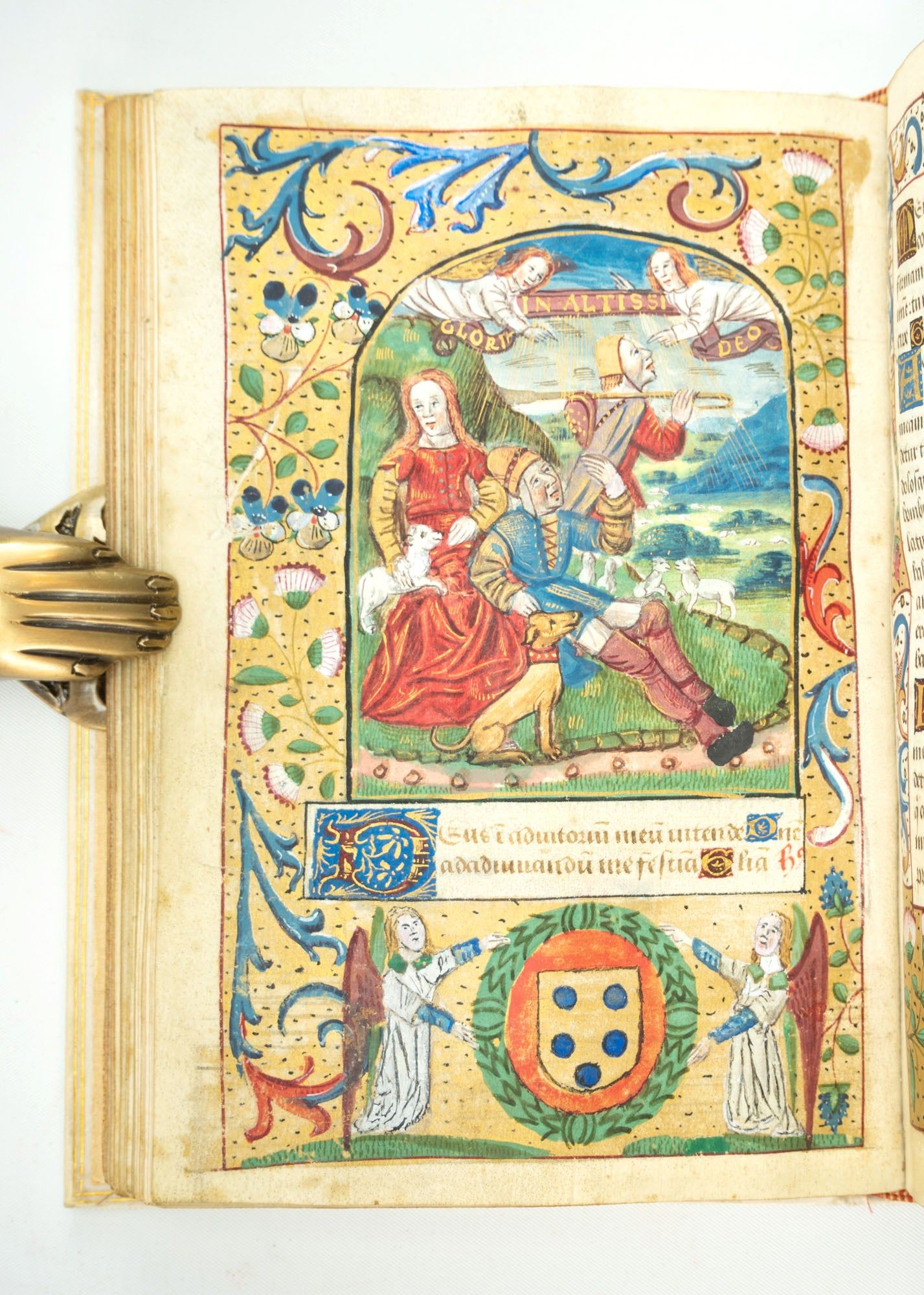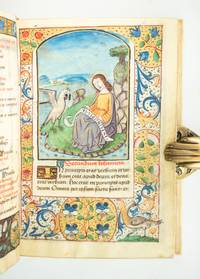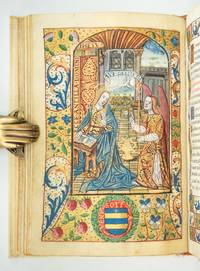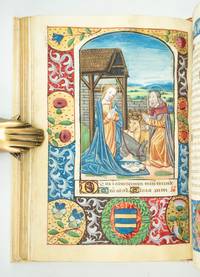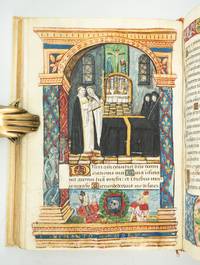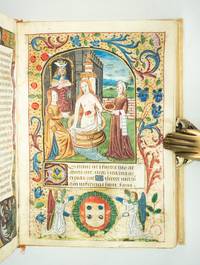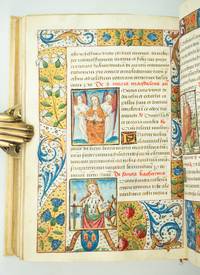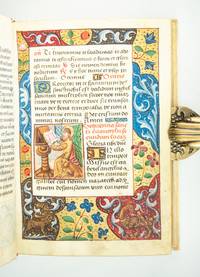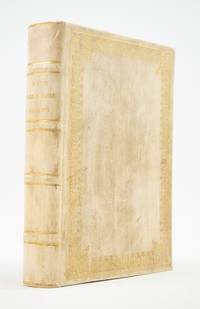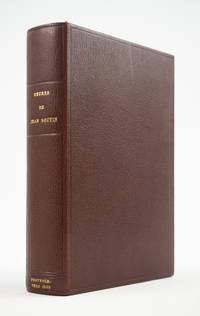USE OF ROME
- SIGNED
- Northern France , late 15th or early 16th century
Northern France, late 15th or early 16th century. 176 x 128 mm. (7 x 5"). Single column, 23 lines in a neat batârde hand. i (blank), 101, ii (blank) leaves. Lacking one leaf after f. 87 (possibly containing a miniature), otherwise complete. Contents: Calendar (f. 1r); Gospel Lessons (f. 7r); Passion according to John (f. 10v); Hours of the Virgin (f. 15v); Penitential Psalms and Litany (f. 45r); Office of the Dead (f. 54v); Hours of the Cross (f. 68v); Hours of the Holy Spirit (f. 70v); Prayers to the Trinity, St. Veronica, "Obsecro Te," "O Intemerata," and "Stabat Mater" (f. 72v); Suffrages (f. 79r); Prayers in French to be said on various occasions (f. 86v); verse prayer in French beginning "Royne des cieulx glorieuse" (f. 90r); additional prayers in French and Latin (f. 93v).
Attractive 19th century vellum with lacy gilt border, raised bands ruled in gilt, gilt lettering, tan silk endleaves, all edges gilt. Housed in a felt-lined reddish-brown pebbled morocco clamshell box with gilt lettering on spine. Rubrics in red, numerous one- and two-line initials in painted gold on burgundy or blue ground, WITH 27 SMALL MINIATURES (one miniature of Christ Carrying the Cross measuring 60 x 68 mm., the rest depicting saints and measuring between eight and nine lines), each surrounded by a full border of acanthus, flowers, and small dots on bare or painted vellum, and 14 LARGE MINIATURES, EACH OPENING WITH A FULL BORDER, either with acanthus and flowers (as before), or architectural, some borders embellished with figures, animals, or hybrids, two with a small scene in the lower margin, and about a dozen with the added coats of arms and/or mottos of Jean Boutin. The subjects of the large miniatures include the following: St. John of Patmos (f. 7r); Annunciation (f. 15v); Visitation (f. 23r); Nativity (f. 27v); Annunciation to the Shepherds (f. 29v); Adoration of the Magi (f. 31v); Presentation in the Temple (f. 33v); Flight into Egypt (f. 35v); Death of the Virgin (f. 38v); Bathsheba bathing (f. 45r); Funeral Mass (f. 54v); Crucifixion (f. 68v); Pentecost (f .70v); Trinity (f. 72v). See: Fairfax-Murray "French," p. 265-266. Vellum binding soiled but perfectly sound. Small portions of some border figures and perhaps three or four(?) miniatures touched up in the 16th(?) century (see below), occasional chipping to white paint, small hole in the border of ff. 11 & 29, light scattered spotting, fading, thumb soiling, and other minor issues, but an attractive and substantially complete manuscript, the illumination extensive and mostly well preserved.
This heavily illustrated Book of Hours is a lovely example of provincial illumination; it calls attention in an interesting way to the influence of printed books on manuscript art; and it contains intriguing traces of an early prominent owner. Our manuscript contains a total of 41 large and small miniatures by a skilled artist who clearly had some training and familiarity with the prevailing styles of the time. The overall appearance of the work suggests the artist or workshop was located in Northern France, and although the figures and backgrounds are indicative of a provincial hand, the rich colors, profuse use of liquid gold, and sumptuous borders are unmistakable marks of luxury. The image of the Trinity is particularly lovely, demanding the viewer's attention with God the Father's piercing gaze, and conveying the majesty of the subject with a patterned throne set against a starry sky. Of special interest here are the compositions of the large miniatures, many of which seem to have been copied from printed Books of Hours of the period. When we talk about the transition from manuscripts to print culture in the late-15th and 16th centuries, the discussion often focuses on how the art of manuscripts influenced the appearance of printed works. There is no better example than Books of Hours, which, in printed editions, often mimic the look of their manuscript predecessors in appearance and the way many were finished by hand. However, as the present example demonstrates, the opposite was also true, as printed works inevitably made their way into the hands of manuscript artists. Some even worked simultaneously both as illustrators for publishers (working with metal- and woodcuts) and as manuscript painters. As a reflection of this point, in the present work, we find distinct similarities between our miniatures and a series of metalcuts used by Philippe Pigouchet for the publisher Simon Vostre beginning in 1496 (Fairfax-Murray's set 2). According to Fairfax-Murray, "These cuts . . . were evidently very favourably received by Pigouchet's rivals and imitators, for one finds several close copies and adaptations in the various productions of other presses," including a very close imitation of woodcut images commissioned by the publisher Antoine Vérard. Evidently the popularity of these plates extended to manuscript artists, and it is fascinating to see the adaptation of each composition to suit the painter's own style and the patron's needs. Most of the compositions in our manuscript are, essentially, simplified versions of the printed miniatures, retaining the central figures, their gestures, garments, and props, but with complex backgrounds eschewed, as are extra figures deemed unnecessary to fulfill the narrative. The resulting miniatures are far less busy than their printed counterparts, allowing the viewer to focus on the central story. In a few instances, the artist has added small scenes beneath the large miniatures. An example, on f. 35, depicts the so-called "Miracle of the Wheat," featuring harvesters misleading Herod's soldiers by (truthfully) saying that the fleeing Holy Family passed by when their (now miraculously matured) crop was just being sown. This kind of inclusion may have been influenced by the copious small metalcut scenes that decorate the borders of numerous printed Books of Hours of this period. The text here follows a fairly typical structure, but includes prayers in French to be said for each day of the week and on various occasions, such as when one awakens or when one leaves a house. Also in French are additional verses to the Virgin--one of which is credited to the Franciscan preacher Jean Tisserand (d. 1497), who founded an order for repentant women. Another accessory prayer included here (f. 98) appeared in both prayer books and conjuring manuals of the period, straddling the line between religion and popular magic. Based on an apocryphal encounter between Pope Leo III and Charlemagne during the Battle of Roncevaux, this prayer was often used as a protective amulet against all manner of evil; here, it is said to "conquer demons and one's enemies." Although we do not know for whom this manuscript was originally made, the book shows a number of marginal customizations in the form of different coats of arms, the motto "Soit avenu" ("Let it come to pass"), and the name of Jean Boutin (written on ff. 23 and 35). This owner could have been Jean Boutin, Sieur de la Court et de Chamballan, and Mayor of Nantes from 1575-76. In addition to the marginal customizations, the manuscript may possibly have some very neat replenishing of white facial paint in a handful of marginal figures and perhaps in a very small number of the miniatures. Using magnification and strong light, we are unable to find convincing evidence that this retouching took place, at least in the miniatures, and if it was, we think it was done quite early (perhaps in the 16th century?). Worst case, it would necessarily be termed subtle and skillful enough to cause uncertainty now, and whatever the verdict is in this respect, the manuscript remains very fresh and attractive, features attractively executed paintings, is complete but for one leaf, and would provide ample room for additional research..
Attractive 19th century vellum with lacy gilt border, raised bands ruled in gilt, gilt lettering, tan silk endleaves, all edges gilt. Housed in a felt-lined reddish-brown pebbled morocco clamshell box with gilt lettering on spine. Rubrics in red, numerous one- and two-line initials in painted gold on burgundy or blue ground, WITH 27 SMALL MINIATURES (one miniature of Christ Carrying the Cross measuring 60 x 68 mm., the rest depicting saints and measuring between eight and nine lines), each surrounded by a full border of acanthus, flowers, and small dots on bare or painted vellum, and 14 LARGE MINIATURES, EACH OPENING WITH A FULL BORDER, either with acanthus and flowers (as before), or architectural, some borders embellished with figures, animals, or hybrids, two with a small scene in the lower margin, and about a dozen with the added coats of arms and/or mottos of Jean Boutin. The subjects of the large miniatures include the following: St. John of Patmos (f. 7r); Annunciation (f. 15v); Visitation (f. 23r); Nativity (f. 27v); Annunciation to the Shepherds (f. 29v); Adoration of the Magi (f. 31v); Presentation in the Temple (f. 33v); Flight into Egypt (f. 35v); Death of the Virgin (f. 38v); Bathsheba bathing (f. 45r); Funeral Mass (f. 54v); Crucifixion (f. 68v); Pentecost (f .70v); Trinity (f. 72v). See: Fairfax-Murray "French," p. 265-266. Vellum binding soiled but perfectly sound. Small portions of some border figures and perhaps three or four(?) miniatures touched up in the 16th(?) century (see below), occasional chipping to white paint, small hole in the border of ff. 11 & 29, light scattered spotting, fading, thumb soiling, and other minor issues, but an attractive and substantially complete manuscript, the illumination extensive and mostly well preserved.
This heavily illustrated Book of Hours is a lovely example of provincial illumination; it calls attention in an interesting way to the influence of printed books on manuscript art; and it contains intriguing traces of an early prominent owner. Our manuscript contains a total of 41 large and small miniatures by a skilled artist who clearly had some training and familiarity with the prevailing styles of the time. The overall appearance of the work suggests the artist or workshop was located in Northern France, and although the figures and backgrounds are indicative of a provincial hand, the rich colors, profuse use of liquid gold, and sumptuous borders are unmistakable marks of luxury. The image of the Trinity is particularly lovely, demanding the viewer's attention with God the Father's piercing gaze, and conveying the majesty of the subject with a patterned throne set against a starry sky. Of special interest here are the compositions of the large miniatures, many of which seem to have been copied from printed Books of Hours of the period. When we talk about the transition from manuscripts to print culture in the late-15th and 16th centuries, the discussion often focuses on how the art of manuscripts influenced the appearance of printed works. There is no better example than Books of Hours, which, in printed editions, often mimic the look of their manuscript predecessors in appearance and the way many were finished by hand. However, as the present example demonstrates, the opposite was also true, as printed works inevitably made their way into the hands of manuscript artists. Some even worked simultaneously both as illustrators for publishers (working with metal- and woodcuts) and as manuscript painters. As a reflection of this point, in the present work, we find distinct similarities between our miniatures and a series of metalcuts used by Philippe Pigouchet for the publisher Simon Vostre beginning in 1496 (Fairfax-Murray's set 2). According to Fairfax-Murray, "These cuts . . . were evidently very favourably received by Pigouchet's rivals and imitators, for one finds several close copies and adaptations in the various productions of other presses," including a very close imitation of woodcut images commissioned by the publisher Antoine Vérard. Evidently the popularity of these plates extended to manuscript artists, and it is fascinating to see the adaptation of each composition to suit the painter's own style and the patron's needs. Most of the compositions in our manuscript are, essentially, simplified versions of the printed miniatures, retaining the central figures, their gestures, garments, and props, but with complex backgrounds eschewed, as are extra figures deemed unnecessary to fulfill the narrative. The resulting miniatures are far less busy than their printed counterparts, allowing the viewer to focus on the central story. In a few instances, the artist has added small scenes beneath the large miniatures. An example, on f. 35, depicts the so-called "Miracle of the Wheat," featuring harvesters misleading Herod's soldiers by (truthfully) saying that the fleeing Holy Family passed by when their (now miraculously matured) crop was just being sown. This kind of inclusion may have been influenced by the copious small metalcut scenes that decorate the borders of numerous printed Books of Hours of this period. The text here follows a fairly typical structure, but includes prayers in French to be said for each day of the week and on various occasions, such as when one awakens or when one leaves a house. Also in French are additional verses to the Virgin--one of which is credited to the Franciscan preacher Jean Tisserand (d. 1497), who founded an order for repentant women. Another accessory prayer included here (f. 98) appeared in both prayer books and conjuring manuals of the period, straddling the line between religion and popular magic. Based on an apocryphal encounter between Pope Leo III and Charlemagne during the Battle of Roncevaux, this prayer was often used as a protective amulet against all manner of evil; here, it is said to "conquer demons and one's enemies." Although we do not know for whom this manuscript was originally made, the book shows a number of marginal customizations in the form of different coats of arms, the motto "Soit avenu" ("Let it come to pass"), and the name of Jean Boutin (written on ff. 23 and 35). This owner could have been Jean Boutin, Sieur de la Court et de Chamballan, and Mayor of Nantes from 1575-76. In addition to the marginal customizations, the manuscript may possibly have some very neat replenishing of white facial paint in a handful of marginal figures and perhaps in a very small number of the miniatures. Using magnification and strong light, we are unable to find convincing evidence that this retouching took place, at least in the miniatures, and if it was, we think it was done quite early (perhaps in the 16th century?). Worst case, it would necessarily be termed subtle and skillful enough to cause uncertainty now, and whatever the verdict is in this respect, the manuscript remains very fresh and attractive, features attractively executed paintings, is complete but for one leaf, and would provide ample room for additional research..


